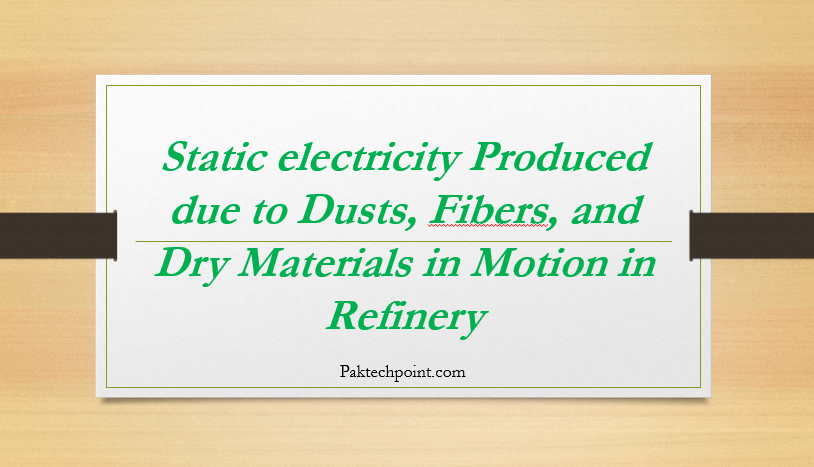Static electricity Produced due to Dusts, Fibers, and Dry Materials in Motion in Refinery
Static electricity is a hazard in processes which involve dusts and other dry materials in motion because they can be ignited in either dust cloud or layer form, and as static generators they can cause static buildup which can result in spark discharges in an ignitable vapor-air mixture. There has been no verification that a dust cloud can be ignited by a static discharge within itself. Static developed by moving films presents a shock hazard to personnel and an ignition hazard to ignitable mixtures, for example coatings or inks associated with the process.
Charge generation occurs when two different materials are separated. Normally one or both materials are nonconductors. Dust dispersed from a surface can develop a considerable charge. The ultimate charge is determined by many variables, for example inherent properties of the substance, size of particles, amount of surface contact, surface conductivity, smoothness of surface, and leakage resistance. High humidity or grounding of the surface from which dust is dispersed will not eliminate the charge generation. The voltage developed by dispersion of dust is proportional to the quantity of dust dispersed, and the maximum voltage developed depends upon the leakage resistance in the system and corona or spark discharge.
There is a certain minimum (average LEL about 0.065 oz of combustible dust per cubic foot of air) dust-air concentration which can be ignited regardless of the spark energy. At concentrations 5 to 10 times this minimum the ignition energy required is minimum. Layers of combustible dust can be ignited by spark discharge. Layers of metallic dusts in most cases require less energy for ignition than carbonaceous materials. See Table II.
When solid nonconductive materials are mixed, ground, screened, or blended, static electricity can be generated. All metal parts of such a system shall be bonded and grounded. Bonding and grounding may be inherent due to metallic connections and mounting on grounded building structure. A value of 100 ohms from any section to ground in a hazardous area is satisfactory.
Moving nonconducting materials, for example paper, cellophane, plastics of various kinds, wool and cotton thread, and synthetic fibers and fabrics, create and store static electricity at points of friction similar to that generated on power transmission belts. Statically charged materials tend to attract or repel each other, or attract foreign materials and, thus, interfere with production. The sparks from static charges also can ignite flammable dusts, metal powders, gases, or vapors. Such charges, can be drained off through (1) material itself, if it conducts electricity, or (2) air surrounding the object, if that is made sufficiently conductive by ionization.
High relative humidity (60 to 70 percent), although it will not stop the generation of static, often will decrease the leakage resistance to the point where charges leak away as rapidly as they are formed. If it is impractical to eliminate static by increasing the electrical conductivity of the material, there remains only one path over which static can be conducted away from objects. This is by the air surrounding the object. Air can be made slightly conductive by the process of ionization.
Static collectors from sheet materials in the form of tinsel bars or rows of needle points, placed near the sheet may ionize the air sufficiently to neutralize the charge on the sheet to a point below the sparking level. Tinsel bar and its application is shown in Figure 3A. Magic wand induction neutralizer is shown in Figure 3B. The ionization of the air is proportional to the intensity of the electrostatic field, and the correct location of a static collector or tinsel bar in relation to the sheet material and roller is shown on Figure 3C. For most dielectric sheet and film materials, the tinsel can be used either in contact with the material or separated by a small distance. Contacting arrangements simplify the problem of static control on winding and unwinding rolls, where changing roll diameter shall be accommodated. This arrangement may cause contamination of
product by tinsel fragments.
Static electricity may result from the passing of abrasives through hoses, for example in sandblasting operations. Static conditions may be dissipated by using special ‘Nonstatic Tubes’ or by bonding the hose nozzle and the material being sandblasted together and running a grounding conductor to a suitable ground. Mixing of powders in poorly conductive solvents can cause a particularly hazardous buildup of static charges. Bonding and grounding precautions, although necessary, are not sufficient to prevent hazardous accumulations of charges during the handling of poorly conductive liquids.
